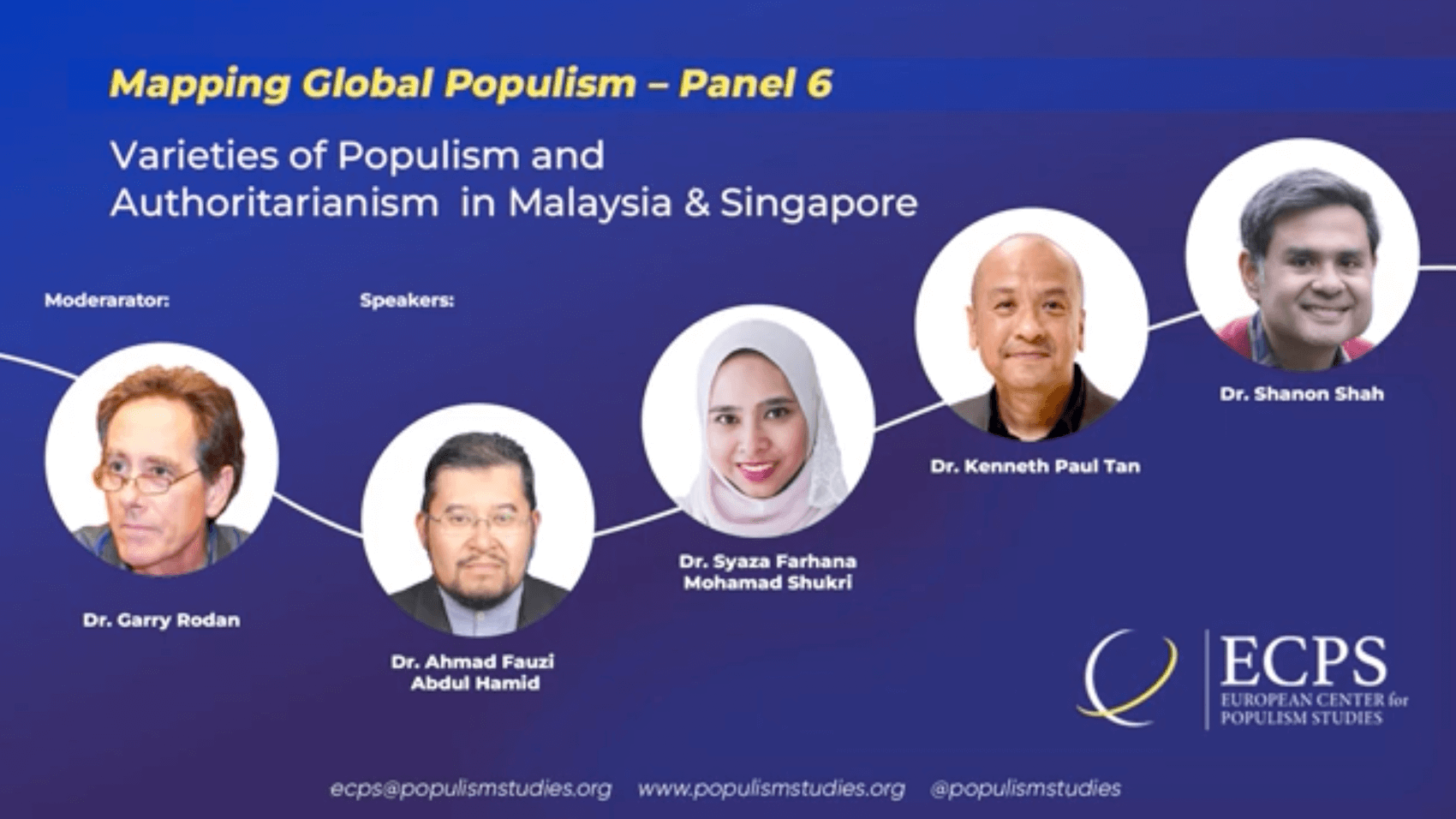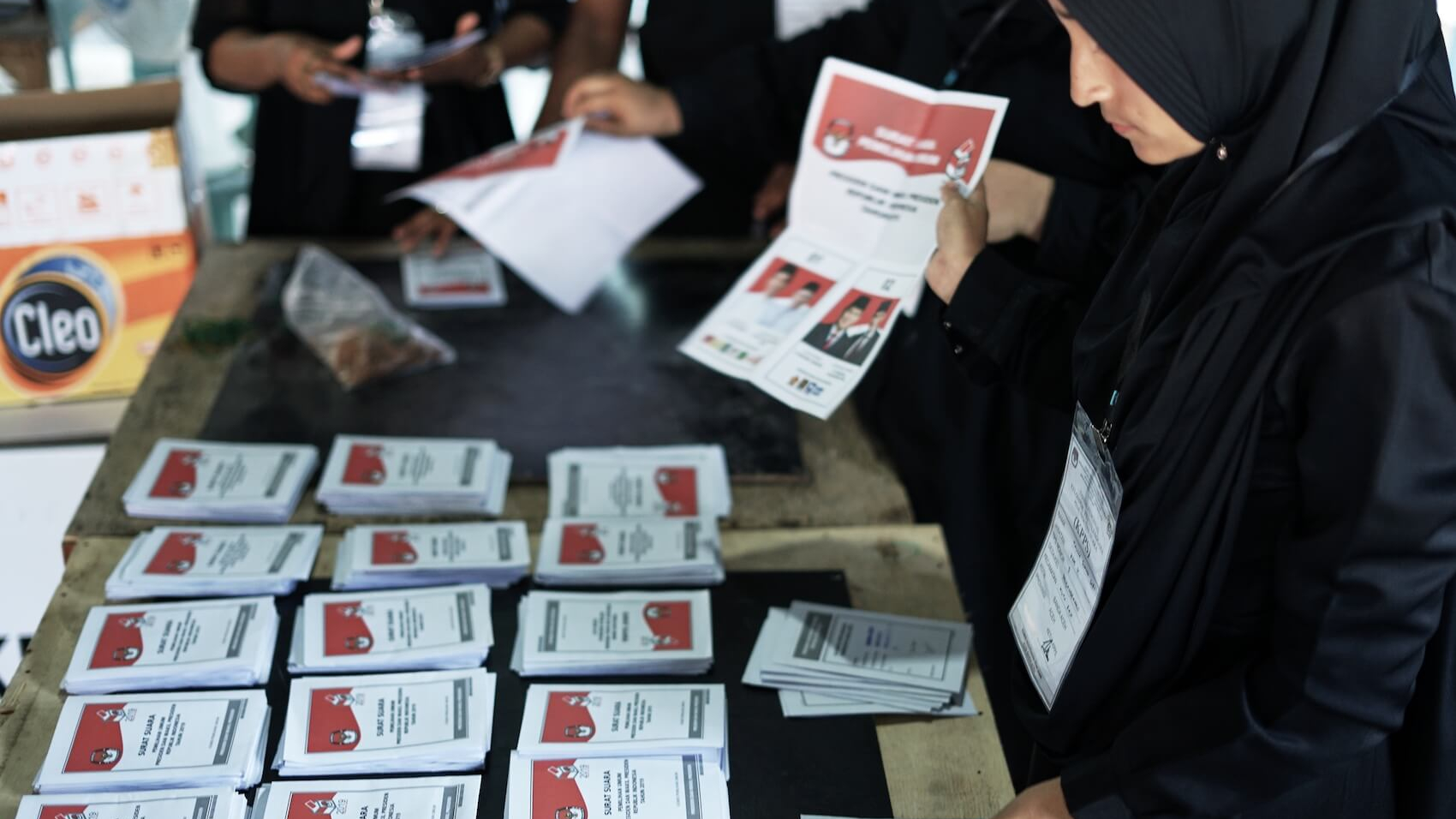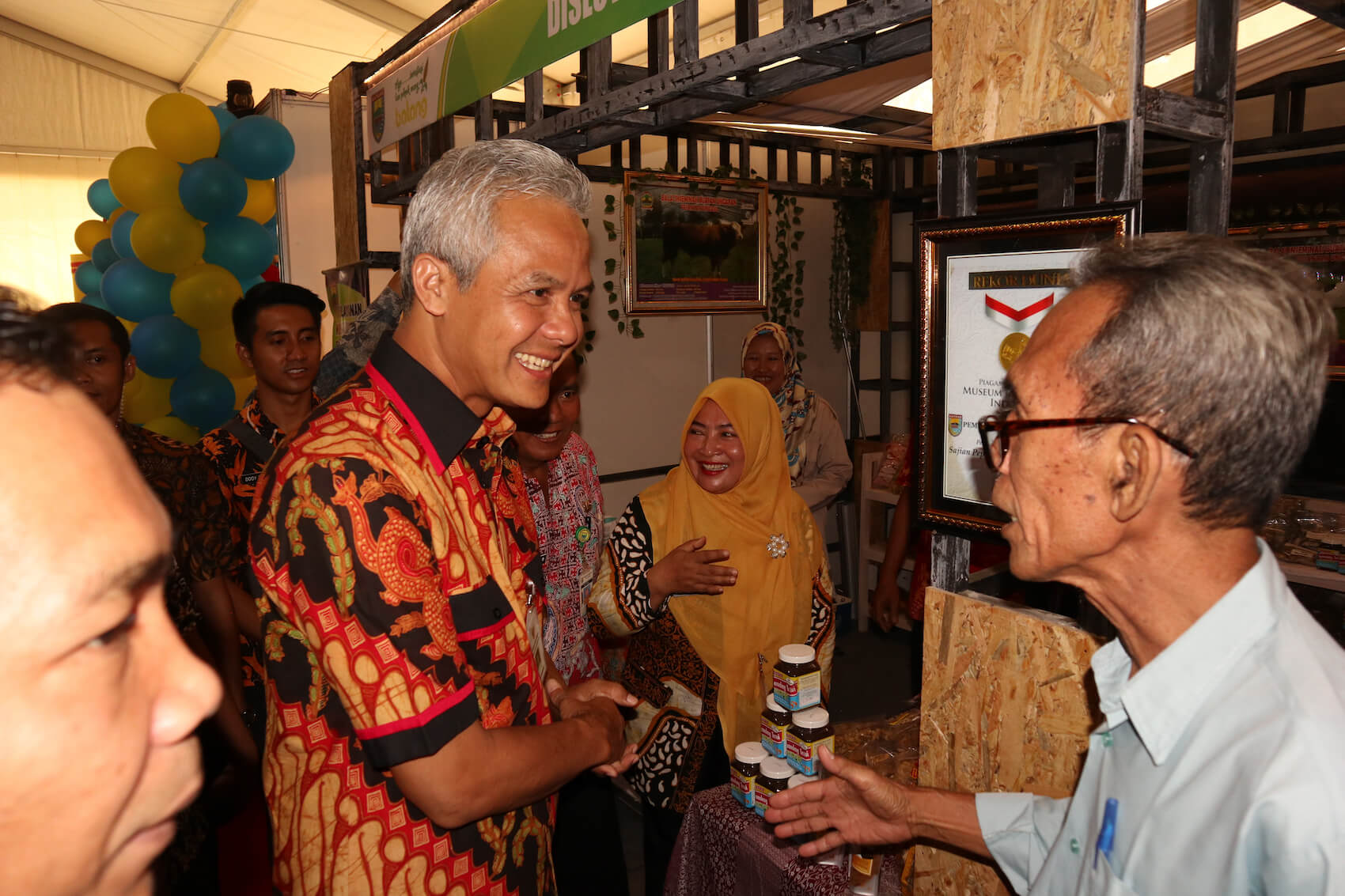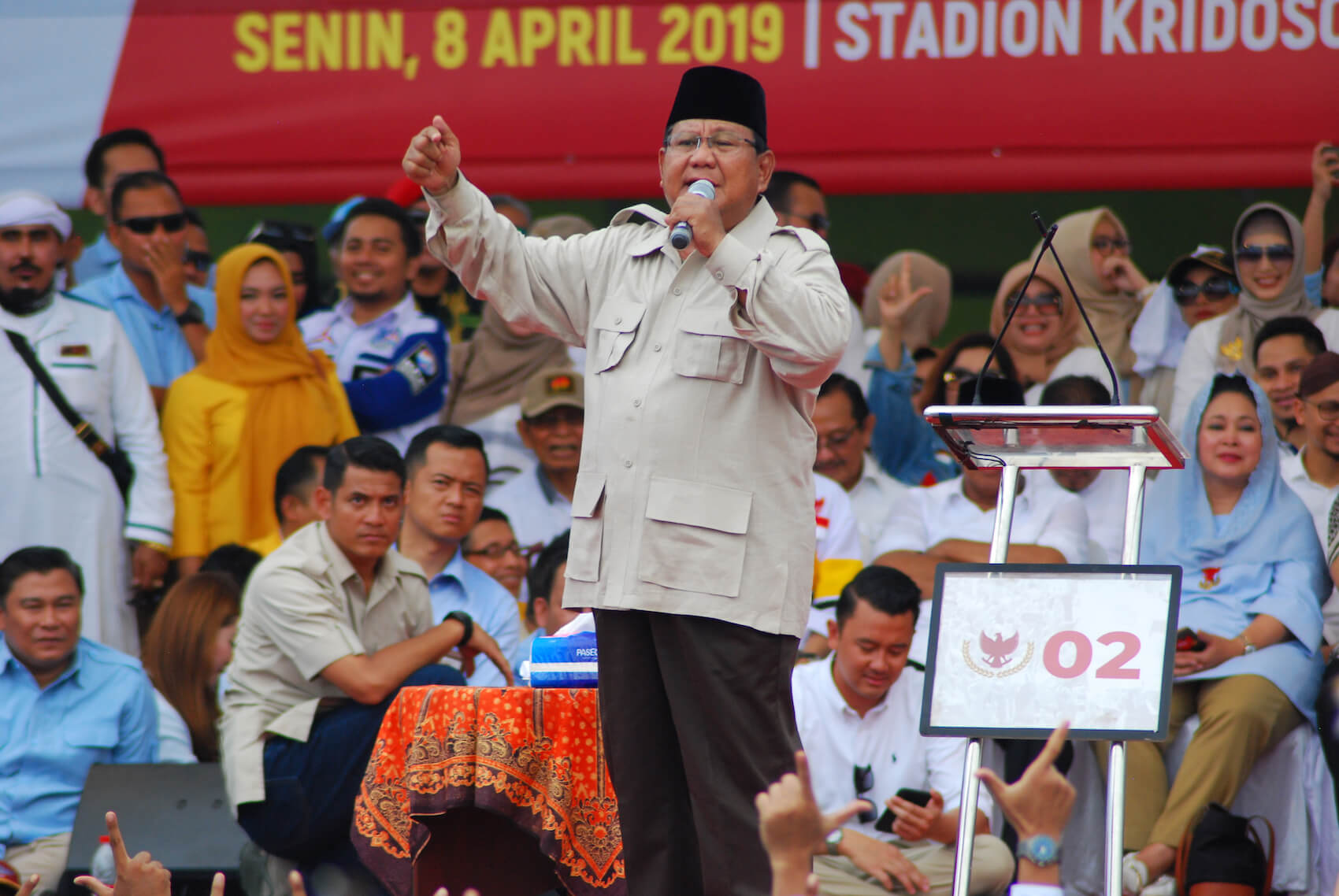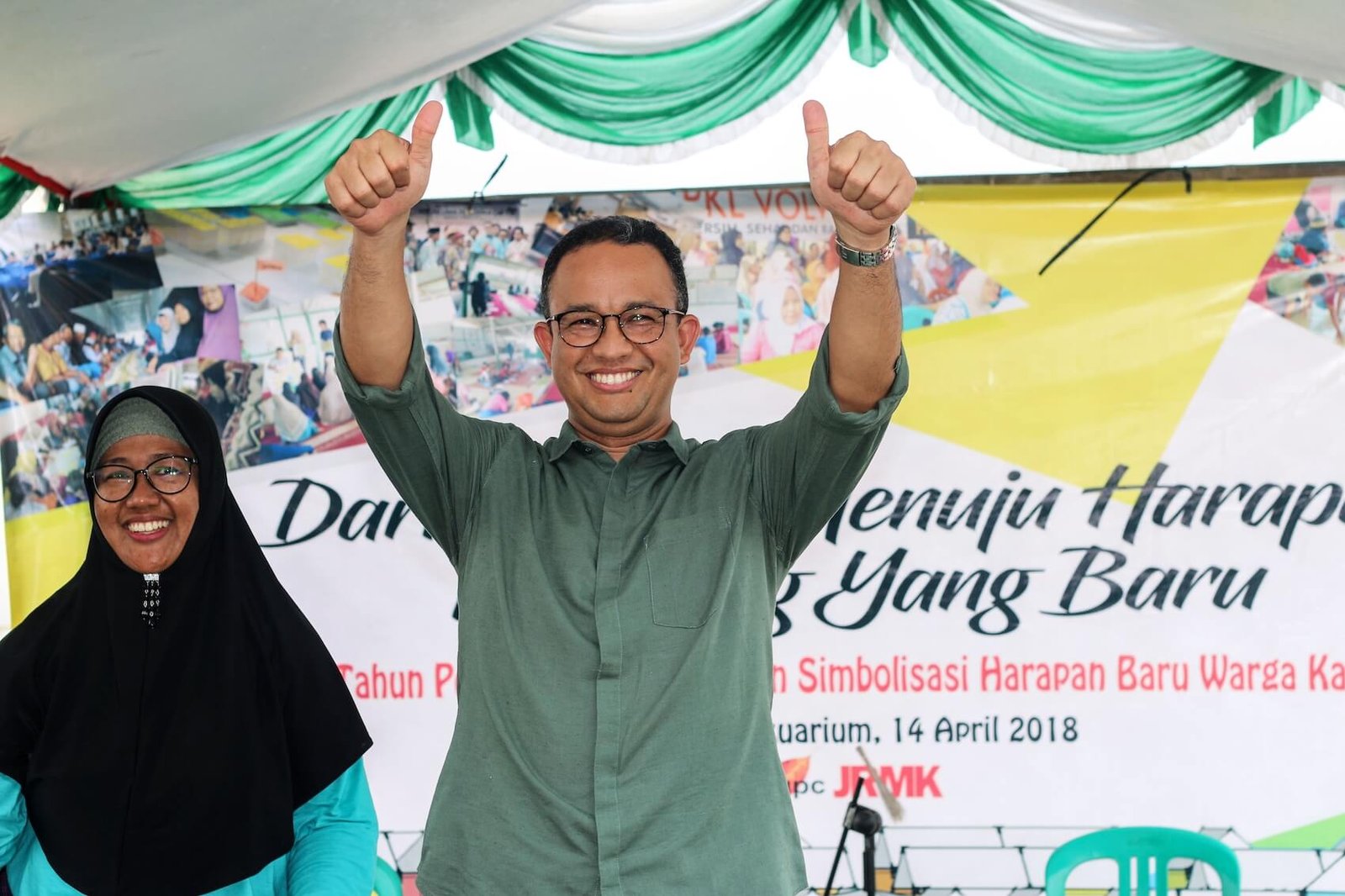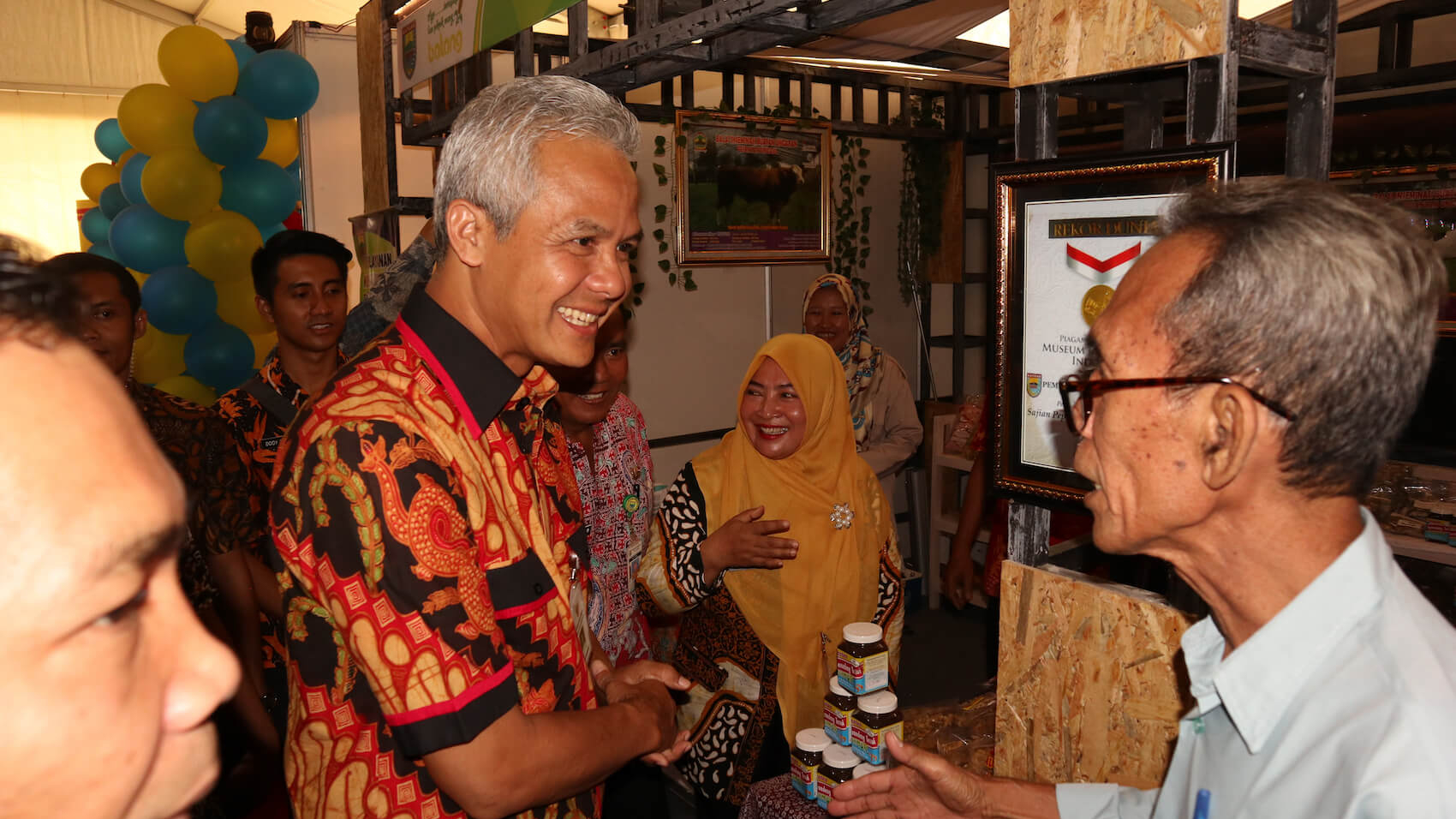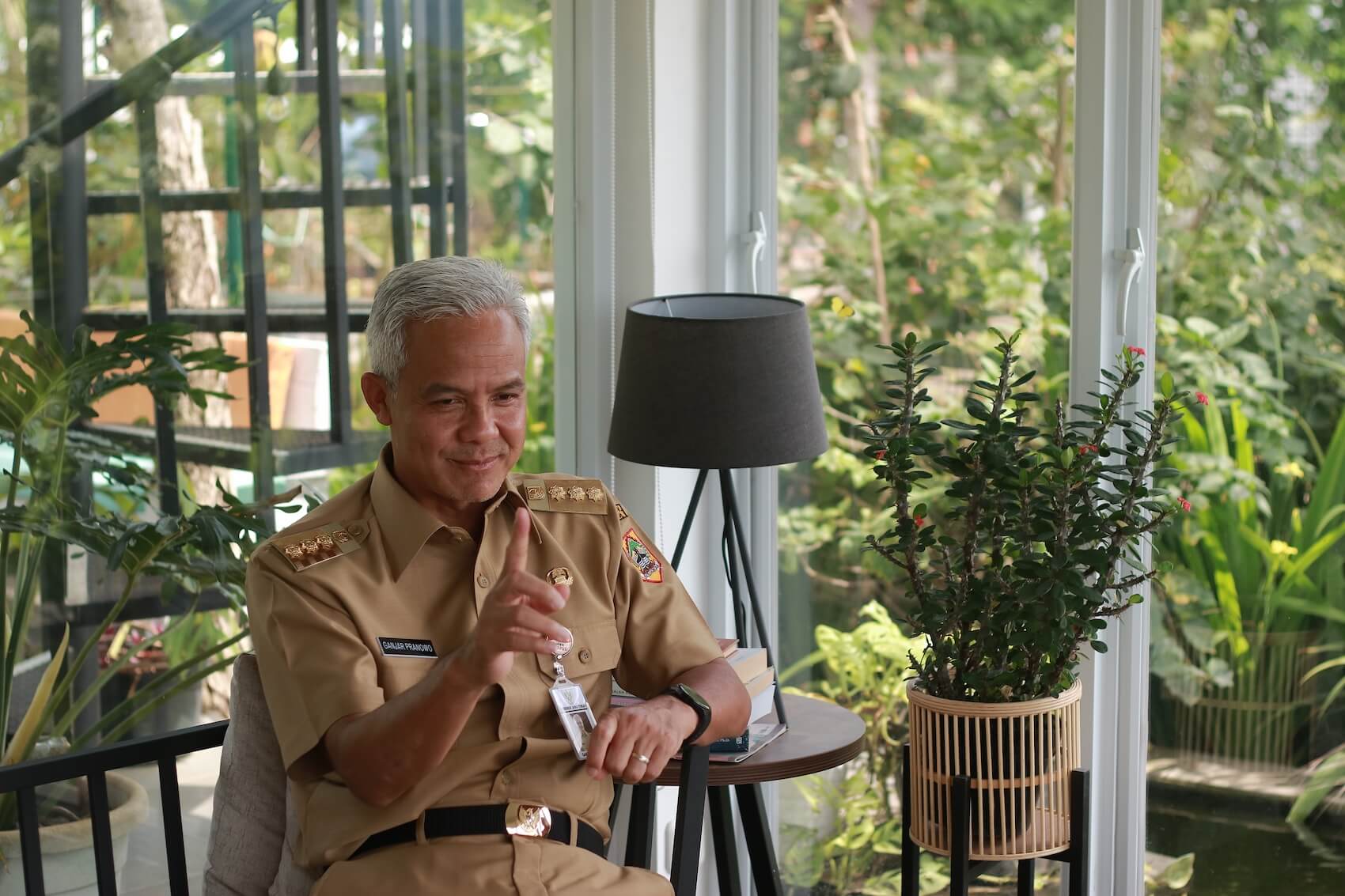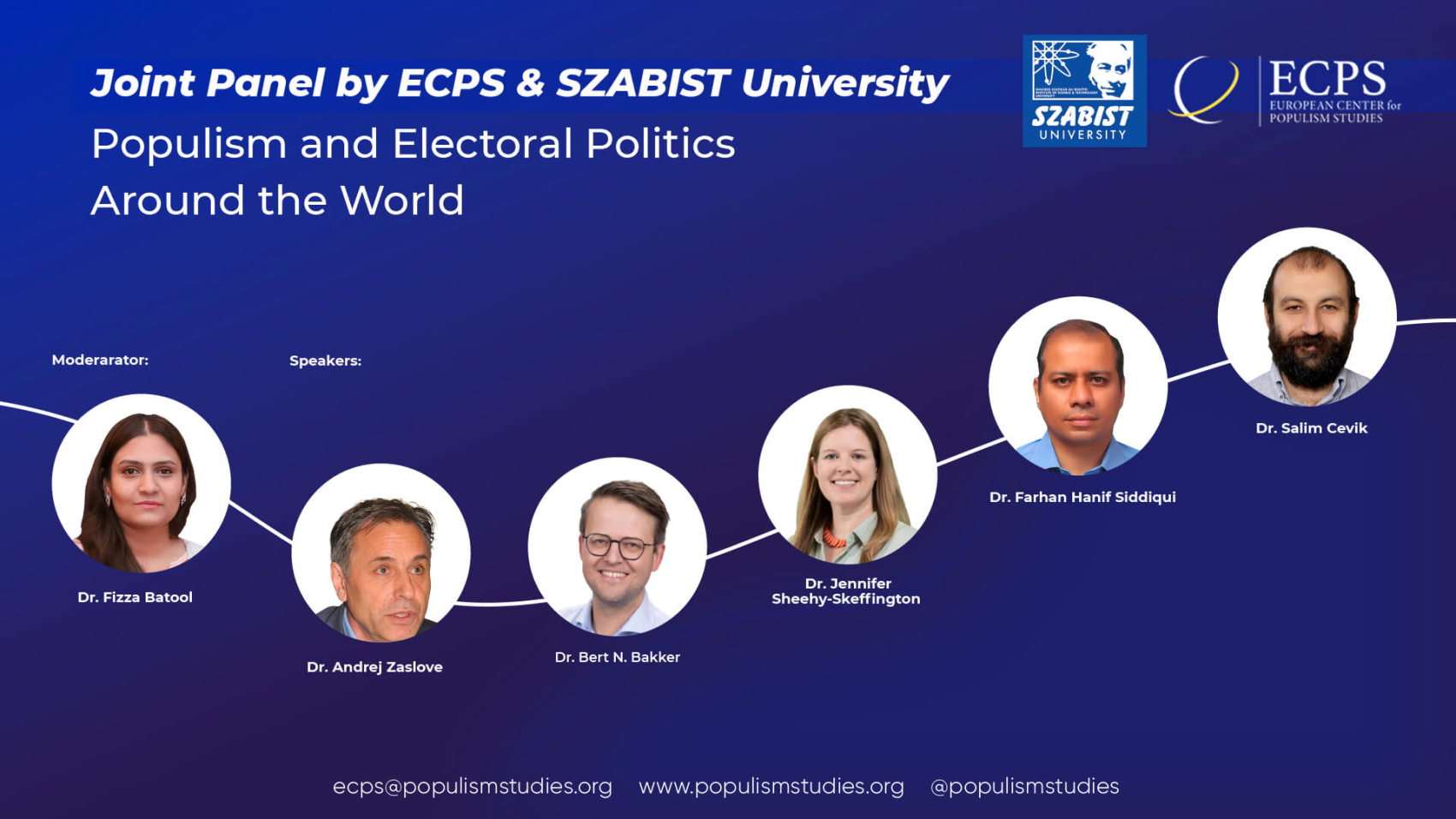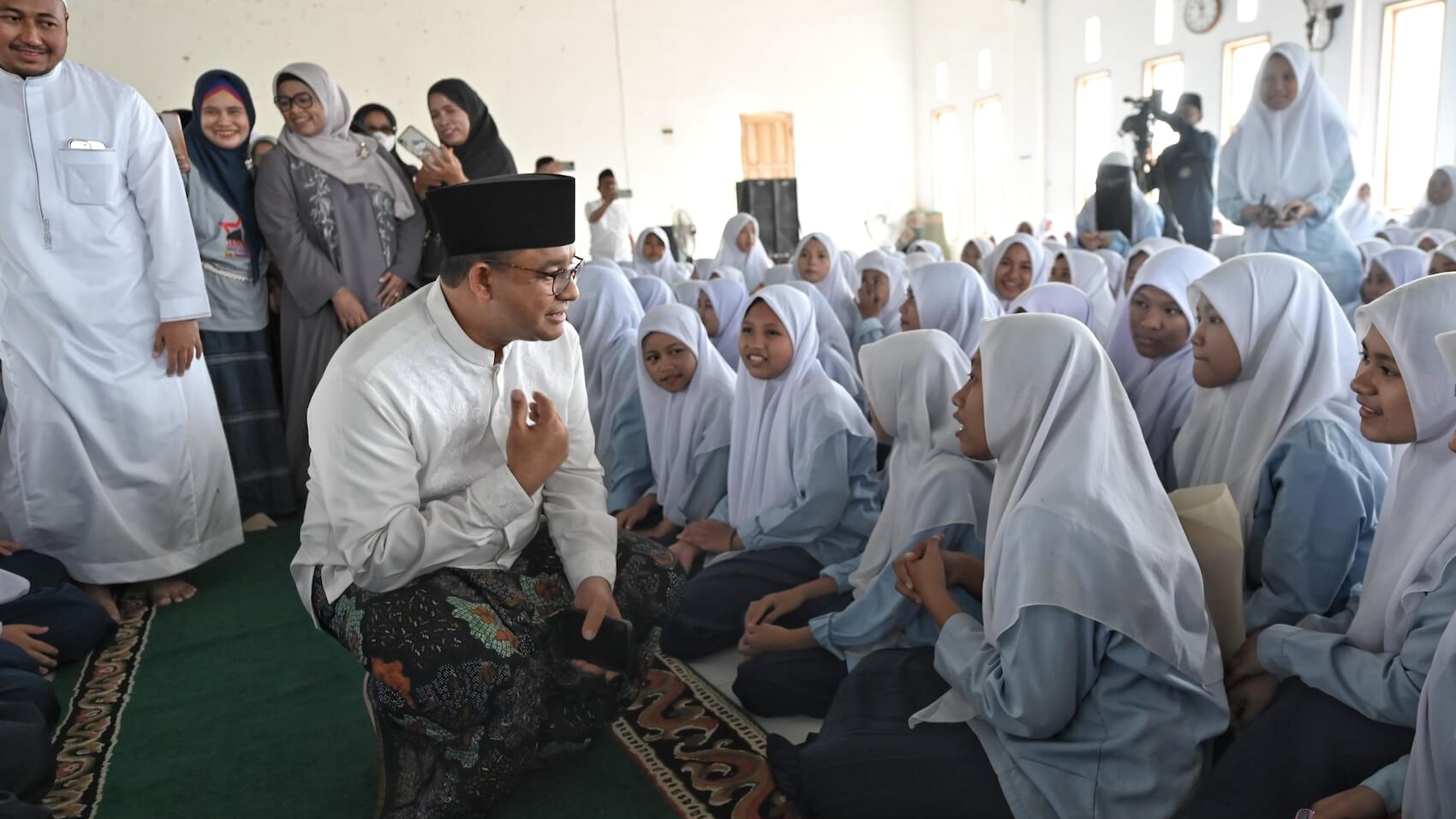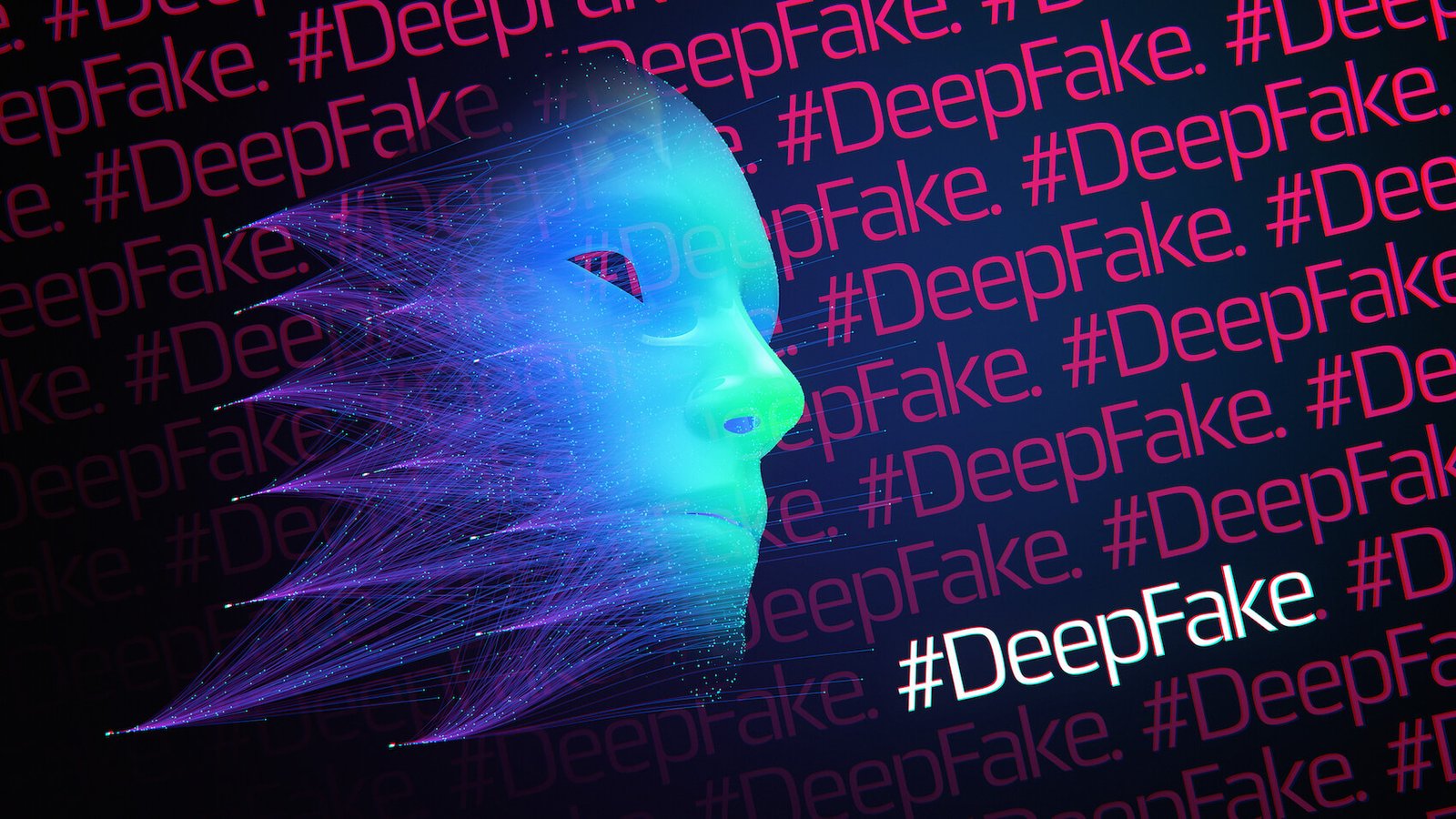Please cite as:
Guidotti, Andrea. (2024). Varieties of Populism and Authoritarianism in Malaysia and Singapore. European Center for Populism Studies (ECPS). January 25, 2024. https://doi.org/10.55271/rp0048
This brief report offers a summary of the sixth event in ECPS’s monthly Mapping Global Populism panel series, titled “Varieties of Populism and Authoritarianism in Malaysia and Singapore” which took place online on October 26, 2023. Professor Garry Rodan moderated the panel, featuring insights from four distinguished populism scholars.
Report by Andrea Guidotti
This report provides an overview of the sixth event in ECPS’s monthly Mapping Global Populism panel series, titled “Varieties of Populism and Authoritarianism in Malaysia and Singapore” held online on October 26, 2023. Moderated by Dr. Garry Rodan, Honorary Professor of Political Science and International Studies at the University of Queensland) the panel featured speakers Dr. Ahmad Fauzi Abdul Hamid, Professor of Political Science, University Sains Malaysia, Dr. Syaza Farhana Mohamad Shukri, Associate Professor at the Department of Political Science, Kulliyyah of Islamic Revealed Knowledge and Human Sciences, International Islamic University Malaysia, Dr. Kenneth Paul Tan, Professor of Politics, Film, and Cultural Studies, School of Communication, Hong Kong Baptist University and Dr. Shanon Shah, Visiting Research Fellow at the Department of Theology and Religious Studies, King’s College London.
In his opening remarks, Professor Gary Rodan examined the interplay between authoritarianism and populism in the contexts of Malaysia and Singapore. Dr. Rodan argued that, generally, the origins of authoritarianism can be linked to colonization. He noted that, despite brief periods of vigorous contestation in the early stages of independence, these two countries diverged in their trajectories toward authoritarianism. In contrast, he highlighted the limited exploration of populism in these countries in the existing literature.
Professor Rodan underscores a significant observation that an examination of the literature on the correlation between authoritarianism and contemporary manifestations of populism in Malaysia and Singapore suggests distinct characteristics and rationales for the effectiveness of authoritarianism. In the early stages of independence in Malaysia, Professor Rodan notes that the political agenda of the United Malays National Organization (UMNO), which later emerged as the predominant ruling coalition, necessitated the development of a political project fostered by an ethnic Malay bourgeoisie and guided by ethnic Malay bureaucrats.
In contrast, as Professor Rodan points out, Singapore witnessed a scenario where a cadre of technocratic political bureaucrats had to contend more strenuously for power, relying on an ideology of elitism centered around meritocracy as the primary justification for the legitimacy of their ruling coalition. Nevertheless, despite these distinctions, both cases experienced challenges stemming from capitalist development over time. Notably, the state capitalist models in the two countries were accompanied by a surge in material and social inequalities.
Continuing with the Malaysian case again, Professor Rodan notes that pervasive corruption has frequently exacerbated cleavages, whether related to or separate from social class. The persistent challenges faced by the ruling coalition over several decades have led to the emergence of new coalitions attempting to contest the dominance of the UMNO within the formal political sphere. However, these challenges have arisen from groups advocating for either democratic reforms or from proponents of the authoritarian political regime rooted in the political supremacy of Malays, with Islamic religious nationalism as its foundation.
Professor Rodan emphasizes that in 2018, amidst escalating political polarization, Malaysia witnessed its first change in the ruling coalition since gaining independence in 1957. The newly formed coalition that assumed governance included the Pakatan Harapan Alliance of Hope and the United Malaysian Indigenous Party. However, this coalition proved short-lived and was subsequently replaced in 2022 by a collaboration between Pakatan Harapan and UMNO, with Anwar Ibrahim serving as prime minister. Despite the involvement of some democratic forces in coalitions, these entities were grappling elements, either striving to protect themselves from democratic forces or to shield themselves from those claiming to be champions of Islam. In essence, there is an intense power struggle over the boundaries of permissible political conflict, favoring a reassertion of authoritarianism in Malaysia’s political landscape.
In Singapore, Professor Rodan notes a recurring shift against the ideology of meritocracy promoted by the People’s Action Party (PAP), particularly by individuals who perceive themselves as having been excluded from the purported economic miracle. The political legitimacy of the PAP faces challenges stemming from conflicts that the party has not entirely addressed, despite some redistributive policies. This differs from the less sophisticated approach observed in Malaysia, highlighting the continuously evolving model in Singapore characterized as a new state-controlled form of participation known as consultative authoritarianism.
In summary, Professor Rodan contends that while Malaysia and Singapore represent different types of regimes, they are both encountering comparable pressures. The central inquiry of the panel revolves around whether, and to what extent, the contemporary nature and trajectory of authoritarianism in Malaysia and Singapore are influenced by populism. Drawing on insights from Anne Munro-Kua’s 1996 book, Authoritarian Populism in Malaysia, Professor Rodan suggests that the political economy of Malaysia since the 1970s has cultivated a communal foundation for political populism, intricately tied to the specific capitalist model.
Dr. Ahmad Fauzi Abdul Hamid: “Political Islam and Islamist Populism in Malaysia: Implications for Nation-Building”
“Contrary to historical patterns, extremism in Malaysia has historically exhibited a high degree of acceptance for pluralism, and instances of violence are rare. Despite notable support for ISIS among Malay Muslims, the country demonstrates low cases of terrorism or violent extremism. Malaysia, being a multiethnic and multireligious nation, enjoys considerable political stability. The data suggests that extremism in Malaysia is primarily attitudinal, with non-violent extremism representing a vocal stance disavowing violence as a matter of principle.”
In his presentation as the first panelist, Professor Ahmad Fauzi Abdul Hamid shifted the focus towards NGO-based populism rather than party politics. Additionally, he sought to establish a close connection between populism and extremism, delving into the concepts of nativism and Islamism, both crucial factors in either jeopardizing or fostering populism in Malaysia.
The initial part of his presentation was dedicated to a conceptual analysis of certain terms. In the context of Islamist populism, Professor Abdul Hamid clarified that it involves a politically arbitrary interpretation of Islam rather than a direct reference to Islam itself. Populism, in this context, signifies the exploitation of the popular sentiments primarily among indigenous Muslims. As for the concept of Islamism, it can be defined as a political ideology advocating for the establishment of a juridical Islamic state governed by Shariah, aiming for practicing Muslims to realize the ideals of Islam as a comprehensive way of life.
In connection to this, extremism, as explained by Professor Abdul Hamid, views politics from a supremacist perspective, delineating boundaries between in-group and out-group categories, often based on race and religion but not exclusively so. Extremism is also considered as an anthropological concept, presupposing the existence of a silent enemy opposed to the dominant or hegemonic force.
In this context, according to Professor Abdul Hamid, Malaysia presents an anomaly due to its history of peaceful Islamic propagation influenced by Sufism. Contrary to historical patterns, extremism in Malaysia has historically exhibited a high degree of acceptance for pluralism, and instances of violence are rare. Despite notable support for ISIS among Malay Muslims, the country demonstrates low cases of terrorism or violent extremism. Malaysia, being a multiethnic and multireligious nation, enjoys considerable political stability. The data suggests that extremism in Malaysia is primarily attitudinal, with non-violent extremism representing a vocal stance disavowing violence as a matter of principle. However, it is crucial to recognize that non-violent extremism poses risks, as it may lead to violence and potentially encourage others to engage in violent forms of extremism.
Viewed from this perspective, there is little distinction between populism and non-violent extremism; the differentiating factor in the Malaysian context is nativism, which upholds the concept of Malay supremacy. Nativist responses in Malaysia have arisen to safeguard Malay identity against perceived threats stemming from globalization and collaboration with non-Malay populations.
Preceding independence, Malay nationalists considered their rights as derived from an implied social contract, recognizing Malays as the original inhabitants in exchange for extending citizenship to non-Malays. This notion is reinforced by constitutional provisions acknowledging Malay indigeneity, as evident in the designation of Islam as the religion of the federation in article 3.1. of the constitution.
The disentanglement of the UMNO as the guardian of Malay interests has challenged this conception. Consequently, Islamist conservative groups have gained prominence, offering populist interpretations of Islamist politics with right-wing extremist elements. This trend commenced in 2008 when UMNO weakened and lost its two-thirds majority. Another surge occurred in 2016 following the election of Donald Trump in the US and Rodrigo Duterte in the Philippines, leading to the emergence of the Islamic group ISMA.
While ISMA explicitly disavows violence, its extremely assertive public discourse has the potential to incite violence among discontented elements of Malay-Muslim society. This risk arises for two reasons: it blurs the line between violent and non-violent extremism, and its asymmetrical stance on special privileges and non-Muslim citizenship rights is rooted in an extreme interpretation of the Muslim Brotherhood. Despite the powerful penetration of ISMA’s discourse into general Muslim society, it has not translated into significant actions. Regarding the medium and methods of ISMA’s discourse, noteworthy is the production of the film “Mat Kilau,” the highest-grossing film of all time in Malaysia. The film was produced by Studio Kembara, whose director, Abdul Rahman Mat Dali, was a former Vice President of ISMA.
In conclusion, Professor Abdul Hamid suggests a disciplinary bias in asserting that extremism or populism is inherently nonviolent. When addressing the challenge of populism, Muslim countries should prioritize local indigenous resources, categories, themes, strategies, strengths, and narratives. The foundation must be indigenously developed, not globally imposed, human rights. The shortcoming lies in the inability to redefine the terms of this discourse in concepts that hold more significance for Muslims residing in the Islamic world.
Dr. Syaza Farhana Mohamad Shukri: “Islamist Civilizationism in Malaysia”
Professor Shukri highlighted several key points during her presentation: ethnonationalism surged after the race riots of 1969 in Malaysia; Mahathir Muhammed’s ambition to become a Muslim world leader set the stage for Islamist civilizational populism; domestic issues contributed to the rise of Islamist populist politicians in the country; in our globally connected world, these Islamist populist politicians utilize civilizational discourse to position Malaysia within the larger Ummah, all while targeting a primarily domestic audience.
The second panelist, Professor Syaza Shukri, centered his discussion on the Islamic civilization in Malaysia, specifically examining the evolution of Islamist civilizational populism. Theoretically, the country’s majority population is legally obligated to be Muslim, so discussions about (native) Malays implicitly involve Islam. Dr. Shukri’s key argument is that developments since the 1960s have paved the way for Malaysian political leaders to adopt a discourse on civilization as a populist strategy in the twenty-first century. In this context, the Malaysian discourse on civilization to the Malay people functions as part of a broader and sacred framework of Islamic civilization and ethno-nationalist populism.
To clarify her argument, Dr. Shukri provided a historical overview. In the past decade, this ethno-nationalist populism has evolved into Islamic civilization populism. This shift means that, rather than solely focusing on defining Malays by their majority, the emphasis is now on Malays as Muslims. The Islamist populists have situated the Islamic identity of Malays within the broader civilization narrative of the Islamic Ummah. This populist narrative designates Malaysia’s majority Malay population as the ‘true people,’ while the Chinese are labeled as the ‘others.’ Following the populist narrative, which pits elites against the people, the Chinese, due to their perceived economic and ethnic dominance, are viewed as the dominant elite against whom Muslim Malays are in opposition.
An important observation pertains to the deliberate use of emotions to evoke fear and resentment, particularly directed towards Chinese economic dominance, said Dr. Shukri. According to her, these populists employ religion to define Islam within the framework of their civilizational rhetoric. They have successfully united Malays against a perceived threat, leveraging the unifying appeal of Islamic civilization. In essence, Islam has been co-opted into a cultural identity.
It is crucial to remember, said Dr. Shukri, that the peninsula and even the Borneo region have been multicultural since at least 500 AD. However, due to their ancestors arriving on the peninsula around 3000 years ago, Malays are considered the original inhabitants of the region. During British colonization, the harmonious relationships among major ethnic groups eroded. When Chinese elites sought entry into the civil service, the British declined. Consequently, special rights were granted to the Malay indigenous population, ensuring, under Article 3 of the Constitution, Islam as the Federation’s religion.
Another pivotal development occurred during the 1969 racial riots, leading to subsequent policies such as the Economic Policy and the National Culture Policy. These policies mandated non-Malays, including Chinese individuals, to assimilate into Malay culture and adopt Malay customs.
The significant cultural and religious renaissance among Malays took place during Mahathir Mohamad’s administration in the 1980s. According to the presentation of Dr. Shukri, his objective was to cultivate employees and leaders across various industries who adhered to value-based duties in accordance with Islam. The institutionalization of Islam in the 1980s strengthened the Islamic identity, laying the groundwork for the subsequent flourishing of Islamic civilization populism in recent years. According to Dr. Shukri, without the rise of Islamization, there wouldn’t have been an audience for such populist grievances. Global challenges such as 9/11 and the war on (religious) terrorism have also played a role in shaping this civilization narrative. Social media, being a significant factor, amplifies beliefs that are at times perceived as persecuted by the actions of Westerners.
In addition to these major events, Dr. Shukri underscored that one of the most significant purported crises facing Malay-Muslims in Malaysia is the rise of Malay political opposition, specifically the Malaysian Islamic Party (Parti Islam Se-Malaysia or PAS). Since 1999, when Anwar Ibrahim launched the reform movement, Malaysia’s opposition has steadily gained support and strength. In 2008, the ruling Barisan National Party failed to secure a two-thirds majority, and in 2013, it did not secure the popular vote, which was instead won by the PAS opposition.
An historic change occurred in 2018 when a segment of the government led by the Chinese-dominated Democratic Action Party raised the secular Malaysian narrative and ideology. Exploiting this development to its advantage, the Pakatan Harapan used it to assert that Malay Muslims were under attack, aligning with the Islamic civilization populist narrative.
Analyzing other prominent political figures, following Cas Mudde’s description, Abdul Hadi Awang (leader of PAS) can be characterized as a typical populist. He has proclaimed that it is forbidden to be aligned with enemies of the religion and the Ummah. Additionally, he has made robust statements against Ukraine’s actions in the Donbass region, drawing parallels to Israel’s ‘genocidal’ policy against Palestinians. Hadi Awang has also criticized Western nations for not aiding Turkey after the 2023 earthquake, accusing them of neglecting to offer assistance to a Muslim country in need.
Another noteworthy example is Muhyiddin Yassin, former president in 2020 and 2021, who asserted that Christians and Jews sought to convert Malaysia into a Christian nation for the purpose of gaining votes. He also accused some orientalist scholars of Islamophobia.
In conclusion, Professor Shukri highlighted several key points: ethnonationalism surged after the race riots of 1969 in Malaysia; Mahathir Muhammed’s ambition to become a Muslim world leader set the stage for Islamist civilizational populism; domestic issues contributed to the rise of Islamist populist politicians in the country; in our globally connected world, these Islamist populist politicians utilize civilizational discourse to position Malaysia within the larger Ummah, all while targeting a primarily domestic audience.
Dr. Kenneth Paul Tan: “Authoritarian Populism in Singapore”
Professor Tan argues that to build a mass support base, the PAP leaders might instigate moral panic, outrage, and become primary purveyors of conspiracy theories against the elite and minority communities. In an environment that has consistently lacked transparency and access to information, coupled with online falsehood laws, there is a risk of heightening the credibility of censored information. The authoritarian technocrats in power may be much less restrained in resorting to moral panic as a diversion from their weaknesses and mistakes.
Professor Kenneth Paul Tan delivered a speech on the panel discussing authoritarianism and populist trends in Singapore. Dr. Tan highlighted that the Singapore state has garnered an international reputation for political stability, social cohesion, economic prosperity, and international correctness. It consistently ranks among the top nations globally and serves as a source of admiration and emulation by others. The success is often attributed to pro-business and globally oriented policies.
The People’s Action Party, which has been in power for an extended period, operates within a one-party-dominant state, securing an overwhelming majority of parliamentary seats in regularly held general elections, providing the incumbent with significant systematic advantages. However, Dr. Tan emphasized that political legitimacy in Singapore is primarily contingent on the state’s ability to meet the citizens’ basic physiological and security needs at an exceptionally high level of satisfaction.
Since the 1990s, some of the most pointed liberal criticisms of Singapore’s approach to democracy, freedoms, and human rights have been gradually overshadowed by a neoliberal celebration of the Singapore governance model. The PAP government takes pride in its ability to pursue policies it deems necessary for Singapore’s long-term interests, even if they are unpopular. The term “populist” is used contemptuously by the PAP and its supporters to accuse critics and opponents of engaging in political posturing that irresponsibly caters to the demands of ordinary people, often characterized as selfish, ignorant, and shortsighted.
Dr. Tan argues that in Singapore, populism remains primarily a derisive term in party political rhetoric, routinely wielded against the ruling party’s opponents, regardless of the merits of their arguments. However, this characterization has become somewhat self-fulfilling. The highly uncompetitive nature of general elections and the growing perception among ordinary Singaporeans regarding the quality of life and personal prospects have created conditions conducive to the emergence and spread of authoritarian populism, with early signs already apparent.
Singapore has a population of about 5.9 million, with only 3.6 million being full citizens. As a postcolonial, multi-ethnic nation-state and a cosmopolitan global city, Singapore presents itself globally as a city of opportunity, but domestically, it portrays itself as a vulnerable nation with significant deficiencies that necessitate opening itself to the world for access to crucial resources and opportunities. This narrative of perpetual anxiety naturally contributes to propagandistic justifications for why the PAP must continue to lead and do so with substantial power.
Dr. Tan states that migration stands as a crucial issue in Singapore, with immigration policies and the presence of foreigners occupying a central place in the public imagination. In essence, an expanding pool of migrant workers exerts downward pressure on the wages of the poorest Singaporeans, while the increasing presence of foreign talent and the super-rich elevates the salaries of top earners. Consequently, this widens the income gap, resulting in Singapore’s Gini index being significantly higher than the OECD average. As the gap widens, there is a growing expectation that social mobility will be reduced in an increasingly dysfunctional meritocracy.
Dr. Tan said Singapore has evolved into one of the most expensive cities globally, with median wages experiencing sluggish growth over the past few decades. This has led ordinary Singaporeans to consistently express concerns about the rising cost of living. Despite being one of the wealthiest cities, visible signs of both relative and absolute poverty persist, yet there are no official poverty line calculations or a strong endorsement for a minimum wage policy.
While Singapore has transformed into a luxurious playground for the affluent, ordinary citizens often perceive a decline in their overall quality of life. Even foreigners have noted the stressful work environment in Singapore, with reports ranking Singaporeans among the top globally for the longest working hours and shortest hours of sleep. Struggling with high stress levels and constant exhaustion, many Singaporeans express deep concerns about their mental health. Presently, these are often cited as reasons by younger Singaporeans for hesitating to start families and have children, contributing to one of the lowest birth rates in the world. Consequently, Singapore turns to immigration as a swift solution to address and sustain a critical mass of labor and talent.
To Dr. Tan, two developments associated with authoritarian populism are evident. Firstly, xenophobic sentiments are triggering latent feelings of racism that have been suppressed by decades of multi-racial conditioning. Emotionally compelling nativist arguments, particularly those directed against the PAP’s immigration policies, can easily find fertile ground for germination. Secondly, even in a traditionally high-trust society like Singapore, there are clear signs of incredulity and resentment towards the elite, or more broadly, the establishment, who seem entitled, self-serving, heartless, and arrogant. In general, ordinary Singaporeans are confronted with a stark view of how the wealthy and powerful live. While Lee Kuan Yew and his leadership were careful to cultivate an image of austerity in the early decades of independence, today’s highly paid political elite find it challenging to conceal the opulence of their lifestyles. Their elitist attitudes are often exposed by numerous pro-PAP individuals that barely escape the scrutiny and publicity of social media.
To conclude his talk, Professor Tan presented some speculations. As today’s elite circles become increasingly closed and protected, one can anticipate institutional decay along with cultural and intellectual exhaustion. Public skepticism has been openly expressed about the competence and moral authority of the next generation of PAP leaders emerging from this decadent elite. The emergence of demagogues, fueled by growing intra-elite rivalries, can be expected. These figures may channel popular energies and frustrations against the traditional establishment and the plural society. To build a mass support base, they might instigate moral panic, outrage, and become primary purveyors of conspiracy theories against the elite and minority communities. In an environment that has consistently lacked transparency and access to information, coupled with online falsehood laws, there is a risk of heightening the credibility of censored information.
Finally, the authoritarian technocrats in power may be much less restrained in resorting to moral panic as a diversion from their weaknesses and mistakes. This not only is expected to increase in frequency but will also be much harder to conceal and deny.
Dr. Shanon Shah: “Populism, Religion, and Anti-LGBTQ+ Attitudes in Malaysia”
Dr. Shah also emphasized the utility of spatial metaphors in distinguishing populism from nationalism. These metaphors are helpful in identifying arguments that manifest in the constructions of opponents or enemies during Malaysia’s current political transition. According to populist conceptions, the construction of in-group out-group relationships is vertical (elite vs. underdog), while in nationalistic conceptions, the relationship is horizontal (pure vs. polluting). Both of these elements contribute to competing narratives of Malaysian nationhood.
The final panelist of the session, Dr. Shanon Shah, sought to apply insights from studies of populism to gain a better understanding of the process of Malaysian Islamization. He referred to the concept of populism as a moral politics, centered around controversies and issues of high significance from a religious or moral perspective, often closely tied to hotly contested elections. This concept was invoked in the context of Pakatan’s Malaysian electoral campaign in 2018, characterized as “savior politics,” framing the elections as a critical moment (elections were framed as a “do or die / now or never”) to save Malaysia from corruption and degeneration.
Dr. Shah also emphasized the utility of spatial metaphors in distinguishing populism from nationalism. These metaphors are helpful in identifying arguments that manifest in the constructions of opponents or enemies during Malaysia’s current political transition. According to populist conceptions, the construction of in-group out-group relationships is vertical (elite vs. underdog), while in nationalistic conceptions, the relationship is horizontal (pure vs. polluting). Both of these elements contribute to competing narratives of Malaysian nationhood.
In the political transition between the 2018 and 2022 elections, a significant number of previously suppressed contenders began articulating their goals based on democratic reforms, achieving success at the ballot box. Following the 2018 elections, the Harapan government faced criticism from nationalist opponents, particularly from AMNO, accusing it of being pro-LGBTQ. This criticism could be seen both as a vertical argument against nationalist adversaries and as a horizontal argument against other parties accused of exceeding their government boundaries.
The Pakatan Harapan government found itself on the defensive when attempting to assert its political administration of Islam, particularly using LGBTQ issues as a testing ground. In 2022, the dynamics shifted as the first shot fired was a personal attack against Anwar Ibrahim, alleging a sexual past. The intent was precisely to portray the prime minister as a proxy of foreign agents.
Dr. Shah extensively discussed the term “Islamization,” acknowledging its lack of clarity. However, when viewed through the lens of populism, it becomes a tool to reveal and highlight ongoing developments in Malaysian society. Zainah Anwar’s paper, co-founder and executive director of the Islamic feminist group Sister in Islam, questions the current state of affairs after years of Islamization. While assuming the existence of Islamization as an ongoing process for decades, her argument suggests that it has detrimentally impacted Malaysian politics, facilitated and endorsed by the political establishment. This perspective can be characterized as the ‘getting worse thesis,’ representing a vertical argument.
On the other hand, anthropologist Michael Peters presents a second narrative, examining long-term trends and noting significant improvements in the delivery of Muslim women’s rights, particularly under Islamic family law. Peters attributes these improvements to both vertical forces (the administration of Sharia courts) and horizontal forces, crediting the long-term activism of groups like ‘Sisters in Islam,’ which he believes has a positive impact on Muslim women. This perspective can be labeled as the ‘getting a bit better thesis.’
The third narrative remains an open question, labeled as the ‘Pandora’s box thesis.’ It explores the potential direction of far-right politics in Malaysian political life, especially with the influential role of social media. Given the familiarity with cyber troopers and trolls, the question arises about how new motifs from far-right hyper-nationalist movements will influence the country’s political landscape and social norms.
The recent political transition in Malaysia has resulted in the Malay population introducing public discourse on issues such as the ‘Black Lives Matter’ movement, rhetoric portraying Chinese individuals as natural outsiders in the country and attempts within the Indian narrative to reinterpret certain aspects of Malaysian history. This phenomenon is genuinely horizontal in nature. The central question remains whether populist politics have influenced the public debate, considering that Islamization has traditionally been assumed to correlate with an anti-LGBTQ stance in the country. Dr. Shah concluded the presentation with a speculative and open question: Are LGBTQ controversies emerging as new rituals of confrontation in the ongoing Malaysian political transition?


